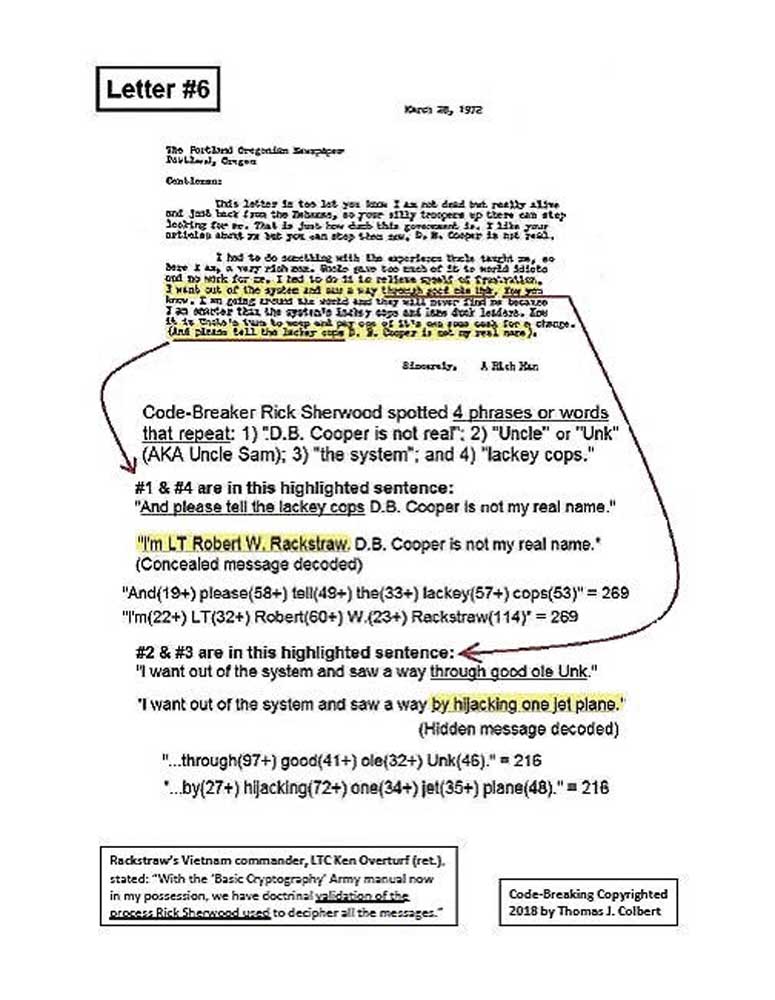D.B. Cooper buffs reveal codes behind theory
Published 8:00 pm Tuesday, August 7, 2018

- D.B. Cooper letter No. 6 — decoded by Rick Sherwood.
The private investigator who dug into Astoria’s past while searching for D.B. Cooper’s identity has chosen to publicly reveal the codes embedded in letters, allegedly from the skyjacker, that point to his top suspect.
In essence, Thomas Colbert, a sleuth from Ventura County, California, and his “Cold Case Team” are showing their work.
Twice this year, Colbert has argued that typed Cooper letters — one from 1971 copied to four major news outlets, another from 1972 sent to The Oregonian — contain coded scripts that implicate Robert Wesley Rackstraw, an ex-convict and Vietnam paratrooper, as the author. Additional letters attributed to Cooper, which have long been public, also contain intriguing clues.
The evidence, according to Colbert, suggests that Rackstraw is the elusive skydiving thief who, on Nov. 24, 1971, armed with a supposed briefcase bomb, commandeered a Boeing 727 flying from Portland to Seattle, ransomed $200,000 upon landing, ordered a trip to Mexico, jumped from the plane unseen above the Oregon-Washington border and vanished with the loot.
Ever since The Oregonian letter came to light earlier this summer, media outlets have been clamoring for the Cooper codes, which are copyrighted, so that readers can arrive at their own conclusions.
“We decided, for history’s sake, to lay it out,” said Colbert, who wrote “The Last Master Outlaw,” a 2016 book about his multiyear search for the culprit.
The two typed letters surfaced within the past year through a Freedom of Information Act request filed by Colbert.
The first letter was sent to the Seattle Times, Los Angeles Times, New York Times and Washington Post shortly after the jump. Each copy included a mishmash of alphabetical letters and numbers that a member of the investigative team, Rick Sherwood, recognized as Army “code speak” used during the Vietnam War.
Sherwood, of Indiana, is an Army Security Agency veteran who once served as Rackstraw’s air traffic controller.
Upon decoding the text, Sherwood said the hidden messages name the three military units that Rackstraw served in during the war: the Army Security Agency, the 371st Radio Research Unit and the 11th General Support Company.
According to retired Col. Ken Overturf, Rackstraw is the only person known to have joined all three units, two of them top secret until the 1980s. It was Overturf’s old Army code book that was used to verify Sherwood’s decryption.
Colbert has called this letter, which included information that only the hijacker would know, “the smoking gun.”
“The fact that you have things in the letter that say it’s Cooper, definitively, and you have Rackstraw’s units, definitively, being the only ones (mentioned) — and he being the only one that would know those units to put them down — what does that tell you?” Colbert asked. “Cooper is Rackstraw.”
The Oregonian letter, mailed several months later, is the one Colbert calls the “confession.”
Sherwood’s deciphering of odd, repetitive phrases yield “I’m Lt. Robert W. Rackstraw” and the act he committed: “hijacking one jet plane.”
“Rackstraw is definitely D.B. Cooper,” Sherwood said. “There’s no doubt in my mind.”
Is Cooper a romantic folk hero who, with one bold act, bucked the system and gave the U.S. government, then embroiled in Vietnam, a lesson in humility? A smug lowlife seeking vengeance and infamy? The anonymity of the slickly dressed outlaw — who wore a dark suit and sunglasses, smoked a cigarette and spoke calmly as he threatened the lives of the passengers and crew — has allowed him to be whatever Cooperites want him to be.
In his narrative of the skyjacker’s whereabouts before the dive, Colbert suspects that Rackstraw, now a San Diego area resident, spent time in Astoria during the summer of ’71 under the alias “Norman De Winter.”
North Coasters remember De Winter, who claimed to be a Swiss baron, as a smooth-talking charlatan who grifted his way through the social scene, taking people’s money and promising a holiday trip to his European estate. Then he, too, disappeared.
No contemporaneous photo of the baron has been found, however, to corroborate Colbert’s claim that Rackstraw — regardless of whether he is Cooper — is De Winter.
Colbert does, however, point to a remark by senior investigator Jon Campbell of the South Carolina Law Enforcement Division: The odds of Rackstraw, De Winter and Cooper — three master criminals with aviation training — all operating in the same general area and seeming to show up when the others go missing are vanishingly small.
The FBI once named Rackstraw a person of interest in the Cooper investigation but cleared him. The bureau closed the case in 2016, announcing that, from then on, it would only accept the money or the parachute. Colbert has accused the FBI of deliberately ignoring his evidence.
When The Daily Astorian asked the 74-year-old Rackstraw in an email exchange if he wrote the typed Cooper letters, he did not respond directly. Instead, he mocked the media and Colbert, and threatened legal action if his name was used.
“Notwithstanding, you will never get the truth from me personally,” he wrote.
While putting the case together, Colbert brought his proof before Jack Schafer, formerly with the FBI’s behavioral analysis program.
Schafer said he was initially a skeptic because “it was a lot of circumstantial evidence.”
The codebreak, which in his view goes beyond circumstantial, changed his mind. “I’m a believer now that Rackstraw’s probably Cooper,” he said.
•••
Cracked by Rick Sherwood, an Army Security Agency veteran who lives in Indiana.
Letter No. 5
Letter No. 5 was sent to the Seattle Times, Los Angeles Times, New York Times and Washington Post. The FBI confiscated all but the Washington Post’s copy. Sherwood broke the code using the Post code and a recovered code from the LA Times.
The letter points to Rackstraw’s three military units in Vietnam: Army Security Agency, the 371st Radio Research Unit and the 11th General Support Company.
The Washington Post copy came with a few codes.
Sherwood said Letter No. 5 was the “key to the code itself.”
First:
“CCCCCCC”: C(3) x 7 = 21
ASA = A(1)+S(19)+A(1) = 21
“ASA” = Army Security Agency
Second, the paper’s name was condensed to “Wash Post.” W(23)+a(1)+s(19)+h(8)+P(16)+o(15)+s(19)+t(20) = 121
Top Secret = T(20)+o(15)+p(16)+S(19)+e(5)+c(3)+r(18)+e(5)+t(20) = 121
Finally, the code 717171684*
42 + *(if * is 8) = 50
371st = 11+s(19)+t(20) = 50
“371st” = 371st Radio Research Unit
Los Angeles Times:
7698QA2753 — can be broken down thus: 47+Q(17)+A(1) = 65;
11th GS = 11+t(20)+h(8)+G(7)+S(19) = 65
“11th GS” = 11th General Support
Letter No. 6
Letter No. 6, also typed, was sent to The Oregonian and dated March 28, 1972:
In the sentence “I want out of the system and saw a way through good ole Unk,” the phrase “through good ole Unk” becomes “by hijacking one jet plane”:
through(97) + good(41) + ole(32) + Unk(46) = 216
by(27) + hijacking(72) + one(34) + jet(35) + plane(48) = 216
Also: “And please tell the lackey cops D.B. Cooper is not my real name” becomes “I’m Lt. Robert W. Rackstraw.”
And(19) + please(58) + tell(49) + the(33) + lackey(57) + cops(53) = 269
I’m(22) + Lt.(32) + Robert(78) + W.(23) + Rackstraw(114) = 269





